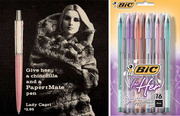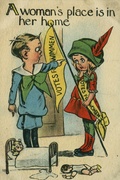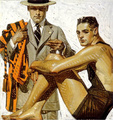The times they are a-changing: Last weekend, lesbian couple Kitty Lambert and Cheryle Rudd made history, exchanging the first gay-marriage nuptials in New York State. Just a few days before, President Obama certified the repeal of the “don’t ask don’t tell” policy in the U.S. military. But homosexuality has not always been so understood and accepted in U.S. society. In fact, in mid-century America, being a lesbian was seen as aberrant and morally corrupt, and because of its social stigma, authors willing to explore this “sin” sold thousands and thousands of paperback books.
Inspired by an amusing slideshow of vintage lesbian pulp fiction covers at The Gloss, we decided to take a look at how gayness—and specifically, lesbianism—was perceived. According to Those Sexy Vintage Sleaze Books, in the 1950s and 1960s, best-selling authors from sci-fi great Robert Silverberg to crime writer Lawrence Block, made ends meets by grinding out softcore porn novels, often using female pen names, to fund their more lofty writing aspirations.
“The salacious nature of pulp fiction gave writers the freedom to explore taboo topics.”
For “Sin Girls,” a lesbian romance, Silverberg wrote under the name “Marlene Longman”—get it? Fellow science-fiction author Harlon Ellison wrote a gushing cover blurb that read, “This is the most powerful novel you will ever read on the subject, written by a woman who is, herself, A TORMENTED LESBIAN!” Years later, on a Yahoo forum, Silverberg commented, “That blurb was incorrect … I was the happiest of lesbians.”
Silverberg had dozens of pen names, including Don Elliott, Loren Beachamp, David Challon, and L.T. Woodard, M.D. Lawrence Block took on pseudonyms such as Sheldon Lord, Dr. Benjamin Morse, Jill Emerson, and Lesley Evans. (Apparently, the androgynous name “Lesley” or “Leslie” was shorthand for “lesbian.”) A handful of these writers, like Sally M. Singer writing as March Hastings, were actual women.
The women depicted on the covers, with their idealized bodies and sexy poses, are clearly meant to appeal to the male gaze, and wallet. The most coveted of these were painted by an illustrator named Isaac Paul Rader, who worked for Midwood Books. His covers were inspired by the works of pin-up artists Alberto Vargas and George Petty, and are now treasured as pocket-sized works of art.
Today, most of these books would be considered highly insulting to lesbians, and women in general. The characters are the equivalent of modern-day female club-hoppers who make out with each other for the paparazzi and to titillate the men around them. As for the standard plot, it goes something like this: The heroine is “turned” by some traumatic event with a man, she runs away to find both pleasure and depravity in the liberal underworld of lesbians, and in the end, she is usually “cured” by a sexual encounter with the man of her dreams.
Ironically, perhaps, the salacious nature of pulp fiction gave writers the freedom to explore taboo topics, with a dose of sensitivity, even. At the time, it wasn’t uncommon for women to wed at an early age and find themselves trapped in loveless marriages, their first and only experience with sex being uncomfortable and unsatisfying. Victims of rape and incest often suffered in silence, afraid of the shame speaking up would bring. And almost no one spoke openly about the female orgasm, a hush-hush subject that was a mystery to many young wives. Since women in general weren’t encouraged to talk about their own desires, lesbians in particular kept it in the closet.
Today, few would suggest that circumstances alone could operate as a switch to flip a woman’s sexual orientation. But in the ’50s and ’60s, lesbianism was deemed an “unnatural” state, something strange or “queer.” Lesbians were dubbed “twilight women” or “the third sex.” Embracing the mainstream social mores was the only way authors could get these stories out into the world, albeit through the porn market. If lesbianism or bisexuality had been presented as a natural state or a valid choice for the characters of these books, the writers and publishers would have faced obscenity charges.
More troubling than the pulps are the supposed nonfiction works, which were really written by fake “doctors” (again pulp writers like Silverberg and Block). Capitalizing on the surging popularity of sexology research by Kinsey and Masters and Johnson, softcore porn publishers of the ’60s began to release short-story collections, presented as a series of true doctor case studies.
Silverberg, for example, published “Twilight Women” as L.T. Woodard, M.D. Block was so bold as to have the confused heroine of “Butch,” by Andrew Shaw (Block), read his fake sexology study, “The Lesbian” by Dr. Benjamin Morse (also Block), and come to the conclusion that the research therein described her!
Obviously, these books were all about profiting off of male fantasies; that’s not so shocking. But when it comes to publishing supposed scientific studies to appeal to the male libido, it’s clear the impact on actual lesbians—who may have wanted to read the experiences of real woman—was not a concern at all.






 Girlie Pens, Again? Why Ordinary Things Go Pink
Girlie Pens, Again? Why Ordinary Things Go Pink
 Before Rockwell, a Gay Artist Defined the Perfect American Male
Before Rockwell, a Gay Artist Defined the Perfect American Male Girlie Pens, Again? Why Ordinary Things Go Pink
Girlie Pens, Again? Why Ordinary Things Go Pink War on Women, Waged in Postcards: Memes From the Suffragist Era
War on Women, Waged in Postcards: Memes From the Suffragist Era Paperback BooksWhen the Beatles’ “Paperback Writer” hit number one in 1966, fans everywher…
Paperback BooksWhen the Beatles’ “Paperback Writer” hit number one in 1966, fans everywher… BooksThere's a richness to antique books that transcends their status as one of …
BooksThere's a richness to antique books that transcends their status as one of … Mari Tepper: Laying it on the Line
Mari Tepper: Laying it on the Line Nice Ice: Valerie Hammond on the Genteel Charm of Vintage Canadian Costume Jewelry
Nice Ice: Valerie Hammond on the Genteel Charm of Vintage Canadian Costume Jewelry How Jim Heimann Got Crazy for California Architecture
How Jim Heimann Got Crazy for California Architecture Modernist Man: Jock Peters May Be the Most Influential Architect You've Never Heard Of
Modernist Man: Jock Peters May Be the Most Influential Architect You've Never Heard Of Meet Cute: Were Kokeshi Dolls the Models for Hello Kitty, Pokemon, and Be@rbrick?
Meet Cute: Were Kokeshi Dolls the Models for Hello Kitty, Pokemon, and Be@rbrick? When the King of Comedy Posters Set His Surreal Sights on the World of Rock 'n' Roll
When the King of Comedy Posters Set His Surreal Sights on the World of Rock 'n' Roll How One Artist Makes New Art From Old Coloring Books and Found Photos
How One Artist Makes New Art From Old Coloring Books and Found Photos Say Cheese! How Bad Photography Has Changed Our Definition of Good Pictures
Say Cheese! How Bad Photography Has Changed Our Definition of Good Pictures Middle Earthenware: One Family's Quest to Reclaim Its Place in British Pottery History
Middle Earthenware: One Family's Quest to Reclaim Its Place in British Pottery History Fancy Fowl: How an Evil Sea Captain and a Beloved Queen Made the World Crave KFC
Fancy Fowl: How an Evil Sea Captain and a Beloved Queen Made the World Crave KFC
Writing has always been a great way to starve. If taking a pen-name and pen-gender and writing porn is how you can pay the rent, then that’s what you do.
Two comments:
Robert Bloch spelled his name with an “h” not a “k”.
Harlan Ellison once dismissed “erotica” with the phrase “When I was writing that stuff, we called it “stiffeners”- but then again we weren’t “artists.”
Thanks for the info, Evin. That’s a great Ellison quote. :)
In this post I’m focusing on the works of Robert Silverberg and Lawrence Block. However, if you know anything about the lesbian or other pulp fiction works of Robert Bloch, I would love to hear about that.
I’ve been collecting these salacious first edition paperbacks for a while, most from the sixties. I pay about 10 to 15 for excellent condition books. What are their average value, and whom are the best writers to collect?